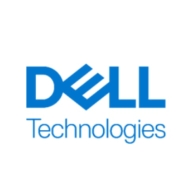


Dell XtremIO and Dell PowerMax compete in the enterprise storage solutions category. Users find Dell XtremIO to have an advantage due to its intuitive interface and simpler setup, while Dell PowerMax is described as having superior advanced features and scalability.
Features: Dell XtremIO offers data deduplication, ease of management, and consistent performance, making it a choice for high data reduction and simplicity. Dell PowerMax provides advanced end-to-end NVMe, real-time machine learning, and robust security features, appealing to organizations focused on cutting-edge technology and scalability.
Room for Improvement: Dell XtremIO could improve in offering advanced technological features and scalability options to compete with PowerMax. Users of XtremIO have also noted room for better integration capabilities. Dell PowerMax could enhance its ease of use and deployment speed, and reduce its high initial pricing to become more competitive with simpler solutions.
Ease of Deployment and Customer Service: Dell PowerMax offers comprehensive deployment options with personalized customer service, focusing on flexibility. In contrast, Dell XtremIO is known for rapid setup and straightforward management, making it suitable for quick deployment without extensive customization.
Pricing and ROI: Dell XtremIO is recognized for competitive setup costs and efficient space-saving technology, leading to significant ROI. Dell PowerMax, despite higher initial expenses, offers a strong return through high performance and extensive technological capabilities. The choice between the two often depends on businesses' budget considerations and long-term performance goals.
| Product | Market Share (%) |
|---|---|
| Dell PowerMax | 4.7% |
| Pure FlashArray X NVMe | 1.1% |
| Dell XtremIO | 0.8% |
| Other | 93.4% |



| Company Size | Count |
|---|---|
| Small Business | 15 |
| Midsize Enterprise | 11 |
| Large Enterprise | 12 |
| Company Size | Count |
|---|---|
| Small Business | 17 |
| Midsize Enterprise | 16 |
| Large Enterprise | 54 |
| Company Size | Count |
|---|---|
| Small Business | 15 |
| Midsize Enterprise | 14 |
| Large Enterprise | 29 |
Pure Storage FlashArray//X is the world’s first enterprise-class, all-NVMe flash storage array. It represents a new class of storage – shared accelerated storage, which is a term coined by Gartner – that delivers major breakthroughs in performance, simplicity, and consolidation.
PowerMax leads in mission-critical enterprise storage with advanced architecture and AI-driven automation, ensuring secure and efficient IT optimization. Its multi-node NVMe scale-out framework delivers unmatched performance and consolidation, backed by Dell’s Future-Proof Program.
PowerMax is renowned for its robust reliability, performance, and efficient data reduction capabilities. Users benefit from its NVMe architecture, aiding significant scalability and cost efficiency through effective deduplication and compression. Unisphere simplifies management, while CloudIQ provides enhanced monitoring. With high availability and strong IOPS capabilities, PowerMax effectively manages demanding workloads and ensures seamless operations. Its compact design and increased storage capacity enhance user experience, particularly with easy maintenance and robust performance.
What are the key features of PowerMax?Dell PowerMax is predominantly employed in mission-critical applications such as SQL, Oracle databases, ERP systems, and high transactional environments. Healthcare, finance, and e-commerce sectors leverage its high performance, scalability, and NVMe technology for low latency and redundancy. It is adept in storage consolidation, data analytics, and disaster recovery.
We monitor all All-Flash Storage reviews to prevent fraudulent reviews and keep review quality high. We do not post reviews by company employees or direct competitors. We validate each review for authenticity via cross-reference with LinkedIn, and personal follow-up with the reviewer when necessary.